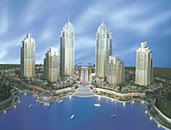Construction Crunch

Elegant view of an up-and-coming Dubai Marina skyline (photo source). Click image for enlarged view.
The Middle East Economic Digest (MEED) in its 21 April 2006 issue writes about a contractor's market in the Gulf, due to the huge number of building projects both planned and underway. This should hardly be of any surprise to anyone driving around Dubai or reading local news publications.
The implications of a contractor's market, however, are not discussed enough in the local media. Instead, one constantly reads of new and ever grander schemes--as though it were the developer who still called the shots.
The construction crunch does not apply to buildings alone. The government of Dubai is continually studying and commissioning new road works. In addition to a 10-flyover interchange currently being constructed at the head of Dubai Marina, a second 10-flyover interchange is being planned toward the far end of the Marina. Furthermore, two additional bridges are being planned to cross the marina canal and new construction is planned for Al Sufouh Road, the primary artery into the Marina, apart from Sheikh Zayed Road.
Projects such as these, including massive undertakings like the new Jebel Ali international airport (renamed Dubai World Central) simply exacerbate the problem.
Grateful for Delays
The unspoken implication in a contractor’s market is that some projects won't get built simply because of a shortage of builders to do the job. Alternatively, projects will be delayed considerably or built at much higher cost than projected. What's more, the problem is not only a shortage of contractors but an ever tightening supply market--i.e. tight supplies of concrete, steel, aluminum, glass, copper, labor, skilled technicians, cranes, bulldozers, scaffolding, and almost whatever else there is that goes into a construction project. It isn't simply a case of Chicken Little and the sky falling down or spot shortages of the odd resource or two. What exists is a local and regional industry operating at full-throttle with no pause in sight and no spare capacity to meet the ever-growing demand.
Those today, mostly investors, who complain about delays numbering months and up to a year or more might in coming years look back on the current situation and count their blessings for having received projects with such minor setbacks. The greatest sense of nostalgia will be felt by those currently awaiting projects to be completed two or three years on, or worse by those waiting for projects yet to break ground.
What is a Developer to Do?
The developer could find itself in a tight squeeze with contractors demanding more, if they even bother to place bids at all. At the same time, investors will continue to noisily demand that projects be delivered on time, at the agreed upon price and without compromise on quality. Something or someone will have to give. One option for the developer is to build the project itself. But such a remedy might represent more a band-aid than a fix. Not to mention that it would be no easy feat to establish a contracting operation on the fly, the real problem would be that the supply market would continue to be as tight as ever.
A more meaningful solution, which one of the MEED articles points to, would be for the developer to arrange partnerships with builders further a field, whether from Europe, America or East Asia. Developers will need to entice new builders to enter the market. It has been common practice for consultants on major projects to be lured from Europe and North America. This practice might need to be applied to the hiring of contractors as well.
In any scenario, the developer’s profit margin will suffer. But those who manage successfully to ride the current crunch, could end up being leaders in the industry once the dust at the larger construction projects begins to settle.
MAG PDD is one developer who may have to face this challenge in the construction of its MAG 218 tower, begun in February 2006. MAG 218 and Its Partners looks at how this developer might effectively respond to such a challenge, by developing additional partnerships.
What about the Investor?
Those whose projects are completed, near completion or at least half-way done are truly the lucky ones. They got their cake when prices were relatively low and will be able to enjoy it by receiving their properties in what will someday seem like record time.
Those whose projects are yet to be started or which are still in the early stages of construction may not be able to eat their cake for some time, but at least they will have it, having locked in relatively modest purchase prices.
For those still yet to buy, with project starts somewhere out on the horizon, the prognosis is perhaps worrisome. They are likely to be looking both at higher prices and longer delays in deliveries, and even cancellations. A project completed in two years time today will probably end up taking up to four years at double the cost, even in the event of an eventual solution to the problem of a shortage of builders and an over-stretched supplies market.
Go to DM Blog latest posts, Dubai Marina Communities or MAG 218 Community homepage.



0 Comments:
Post a Comment
<< Home